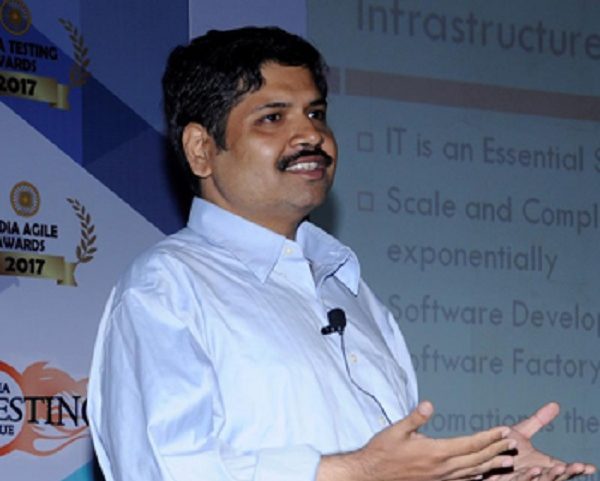Training courses at IoTShow are a quick and fun way for you to upskill yourself and give a boost to your earnings and career growth in 2019. These courses are taught by experienced leaders in technology, and you will be provided a certificate upon completion of training at the venue in a 3-hour session. Certificates will be couriered to you after the event.
HOW TO BUY?
Trainings are available from as low as Rs. 2,999 onwards. Platinum pass holders get an enormous discount of 50%!
You can buy any of these Training Courses by logging into your IEW account, after you signup for a pass. Even free Bronze pass holders can buy a training course after logging in. Platinum pass holders get an enormous discount (of 50%!) on all training courses, so if you are attending 2 or more training courses, you can save by considering a Platinum pass first.
All training will be on one of the days between 26 to 28 February 2019 at IoTShow.in and IEW, in KTPO, Whitefield, Bangalore.
Below are a few training courses that will be hosted at IoTShow.in and India Electronics Week 2019. We will be adding more as we get closer to the event.
| Hall | Morning 26th Feb (10:30 AM-1:30 PM) |
|---|---|
| Training Hall 1 | HANDS-ON LEARNING ON: SHOP FLOOR TO CLOUD (PERFECTING INDUSTRIAL IoT) |
| Training Hall 2 | SENSOR TO APP: A HANDS-ON TRAINING TO BUILD YOUR END TO END IoT SOLUTION |
| Training Hall 3 | TRAINING ON IoT IN AGRICULTURE |
| Hall | Evening 26th Feb (2:00 PM-5:00 PM) |
|---|---|
| Training Hall 1 | HACKING, SECURITY AND HARDENING OVERVIEW FOR DEVELOPERS – ON THE LINUX OS AND SYSTEMS APPLICATIONS, WITH FOCUS ON BoF |
| Training Hall 2 | WORKSHOP ON AZURE SPHERE – A SOLUTION FOR HIGHLY SECURED AND CONNECTED MICROCONTROLLER DEVICES |
| Training Hall 3 | IoT APPLICATION DESIGN TRAINING |
| Hall | Morning 27th Feb (10:30 AM-1:30 PM) |
|---|---|
| Training Hall 1 | INTEL VISION TECHNOLOGY WORKSHOP (FULL DAY WORKSHOP) |
| Training Hall 2 | WORKSHOP ON FROM STANDARD PLATFORM TO OUTSTANDING MOTION APPLICATION |
| Training Hall 3 | HANDS-ON TRAINING FOR PYTHON FOR DATA SCIENCE |
| Hall | Evening 27th Feb (2:00 PM-5:00 PM) |
|---|---|
| Training Hall 1 | INTEL VISION TECHNOLOGY WORKSHOP (FULL DAY WORKSHOP) |
| Training Hall 2 | HANDS-ON TRAINING ON HOW TO BUILD YOUR DRONE |
| Training Hall 3 | TRAINING ON EDGE ANALYTICS – EMERGING FUNCTIONAL AND ARCHITECTURAL PATTERNS |
| Hall | Full Day 28th Feb (11:00 AM-4:00 PM) |
|---|---|
| Conference Hall C | INTENSIVE UX DESIGN COURSE ON IoT |
| Hall | Morning 28th Feb (10:30 AM-1:30 PM) |
|---|---|
| Training Hall 1 | TRAINING ON FIRMWARE REVERSE ENGINEERING |
| Training Hall 2 | TRAINING ON BASICS OF ARDUINO |
| Training Hall 3 | FROM ZERO TO BUILDING YOUR FIRST IoT DEVICE |
| Hall | Set B: Evening 28th Feb (2:00 PM-5:00 PM) |
|---|---|
| Training Hall 1 | TRAINING ON AI (HIERARCHICAL TEMPORAL MEMORY OR HTM) |
| Training Hall 2 | TRAINING ON TWEET DRIVEN #IoTShow STORYTELLING |
| Training Hall 3 | BUILD BLOCKCHAIN SOLUTIONS FOR ENTERPRISE WITH HYPERLEDGER FABRIC |
SENSOR-TO-APP : A HANDS-ON TRAINING TO BUILD YOUR END-TO-END IOT SOLUTION
By Syed Adil, Hardware Design Head, Emertxe Information Technologies
IoT is a cross-functional paradigm, where there are multiple entities come together to give ‘connect-anything-to-everything’ push. In a typical case it would consist of a Sensor -> IoT Device -> IoT Gateway -> Network -> Cloud Platform -> Application. This training will focus on providing participants with an end-to-end solution building experience by giving a hands-on programming view of Sensors, IoT Device (Micro-controllers), IoT Gateway (OS based device) and integrated view of Cloud Platform and Configuring / Tuning Applications.
Subtopics
- IoT Architecture
- Understanding the Thing (Device) aspect and its data flow
- Deciding the sensor Interface
- Understanding the schematics to interface sensors
- Programming Things
- Programming IoT Gateway
- Creating Multi-tasking Applications
- Overview of IoT protocols
- Integrating with IoT cloud platforms
- End-to-end solution / use-case testing
Key Takeaways
- Get an understanding of IoT Architecture
- Programming Embedded Systems part of IoT solution
- Integrating Cloud Platforms of IoT solution
Prerequisites
- Basic programming knowledge of C / Python
- Introductory knowledge of programming any Microcontrollers
- Basic OS knowledge.
Target Audience
Anybody who wants to get a full view of how to building a real-time IoT solution.
Skill level: INTERMEDIATE

HOW TO BUILD A DRONE
By Anima Agarwal, Founder, and Director, WAVEKIDS
Break the ice with Drone Technology by learning the concepts and applications of Drones. Build and fly your very own Pluto Drone and enjoy a hands-on experience.
Subtopics
- Definition and Uses of Drones
- Aerodynamics: Explanation of forces and axes involved in flying
- Understanding of forces of flight
- Equilibrium: Understanding stable and unstable systems
- Sensors: Accelerometer, Gyro Sensor, Barometer and magnetometer
- Introduction to drone programming
- Connecting to IDE
- Flashing and running the user code on the Drones
Key Takeaways
Technologies like the Internet of Things (IoT), robotics and drones will define the future of the world. Learning Arduino is a step towards learning IOT and drones too.
Prerequisites
- 64- bit laptop (Windows/ Mac/ Linux)
- Download Cygnus IDE ( https://tinyurl.com/cygnusIDE) on your laptop
- Android Phone with Pluto Controller
- Notebook
- Pen
Target Audience
Students and working professionals who want to learn about Drones.
Skill level: BEGINNER

HANDS-ON TRAINING ON HIERARCHICAL TEMPORAL MEMORY (HTM)
By Monojit Basu, Founder, and Director, TechYugadi IT Solutions and Consulting.
Hierarchical Temporal Memory is inspired by the capability of the human brain to process ‘high order sequences’ – that is, continuous and concurrent streams of data from multiple sources. Accordingly, this technique shines in detecting not just static patterns, but time-based patterns from data using multiple sources simultaneously. This capability is essential to human intelligence. This capability may also be relevant in designing cognitive analytics on continuous streams of multi-source data generated in IoT-based systems (including Industrial IoT).
In this training, we will use as a reference, open source Numenta HTM, an implementation of HTM built over the last fifteen years (and evolving). We will first present a conceptual overview of HTM, and then run a live experiment for pattern recognition and anomaly detection on sensor data, to help translate the theory into practice. We will also introduce attendees to Numenta HTM Studio that may be suitable for non-technical business analysts.
Key Takeaways
- Familiarize yourself with a few recent trends in AI research
- Actually get to run your first experiment on a futuristic HTM platform
- Take home a pre-configured set-up (virtual machine) for further exploration s
Prerequisites
Awareness of one or two machine learning techniques for classification will help, but it is not mandatory for attending this training.
Target Audience
Developers, Architects, Technical Managers
Skill level: INTERMEDIATE

HACKING, SECURITY AND HARDENING OVERVIEW FOR DEVELOPERS – ON THE LINUX OS AND SYSTEMS APPLICATIONS, WITH FOCUS ON BOF (BUFFER OVERFLOW)
By Kaiwan N Billimoria, Proprietor, kaiwanTECH
The phenomenal rise in technology, and especially, software-driven products (domains like networking, telecom, embedded-automotive, infotainment, and especially now IoT, ML, AI) literally begs for better security on end-products. Hackers currently have a field day! and are only getting better at it, while product developers lag behind. Not a good thing. This presentation is geared towards helping participants understand why and where software vulnerabilities exist, while programming and after; available OS Hardening techniques; what tools and methodologies help prevent and mitigate security issues. The training essentially consists of 3 parts: – Part 1: Security/Hacking Intro – Part 2 : Technical: deep dive into software vulnerabilities, their root causes, process stack – Part 3 : Technical: Modern OS Hardening Countermeasures (esp on Linux). Details: areas it covers includes: Part 1 – Terminology – Current State of Security. Part 2 – Tech Prelim: the process stack – BoF (Buffer Overflow) Vulnerabilities – Demo of a BoF on an ARM VM. Part 3 – Modern OS Hardening Countermeasures – state of Linux OS in particular.
Key Takeaways
- An eye-opener to the need to design and implement software with security in mind
- The current state of security, especially wrt the Linux ecosystem
- Current technical tools to make use of during product development, importantly, on the Linux OS, what hardening countermeasures could (and should) be made.
Target Audience
Folks with exposure to systems programming with ‘C’ / OS developers (knowledge of basic ‘C’/C++, OS basics).
Skill level: ADVANCED

TRAINING ON IOT IN AGRICULTURE
By Mohan Satyaranjan, CTO, Arthospira Agroponics Pvt. Ltd.
The ‘Digital Revolution’ is transforming farming. Rapid advances are being made with initiatives such as ‘more crop per drop’, and ‘farm to fork’. The approach in all such initiatives has been based on using smart, connected technologies with intelligent analytics for monitoring, visibility, planning, consumable optimisation, yield maximisation, and supply-chain loss minimisation. Technologies that enable quick, and easy verification of authentication of high-value certifications such as “organic”, are growing in demand. Ability to ‘trace the origin’ of an agricultural product from any time, anywhere is becoming an expectation. Combination of these technologies is also being referred to as ‘Farming 4.0”. For an EE, all of these are applications of IoT in Agriculture. It is an active area of research internationally, and a tutorial on this topic is most appropriate contemporary topic The productivity, and earnings of farmers in India is amongst the lowest in the world. This is despite India being ‘number one’ producer of a number of food items. 30-50% of food is wasted in the Supply-Chain. Cold-chain, appropriate storage, and other loss prevention techniques can minimise losses.
Key Takeaways
- What are the IoT opportunities in the application area of Agriculture?
- How to choose the right technology in agriculture and build solutions.
Target Audience
Engineers (IoT, Automation, CS, EE/ECE) working in the area of IoT are the targeted audience.
Skill level: INTERMEDIATE

IOT APPLICATION DESIGN TRAINING
By Syam Madanapalli, Director – IoT, NTT Data
This training provides a basic introduction to the Internet of Things for all stakeholders in the tech industry, all verticals and for all levels of practitioners. The training covers the need for the things to be connected over the Internet and how the Internet is evolving to accommodate the connectivity for billions to trillions of devices. The definition and characteristics of the things will be discussed. A basic introduction to the access and networking technologies for realizing the IoT networks will be given. In addition, a few fundamental designing principles for building things and IoT networks will be discussed. – Half a day – theory – Half a day – the attendees form the teams, pick a problem, put up a design on chart papers for the chosen problem and present.
Key Takeaways
- Feel the internet of Things
- Recognize the value of IoT and the benefits this technology innovation brings to the businesses and society
- Apply IoT to solve every problem that s/he comes across.
Target Audience
Anyone who care to solve the problems to make the world a better place to live.
Skill level: BEGINNER

HANDS-ON TRAINING ON PYTHON FOR DATA SCIENCE
By Shadab Hussain, Data Scientist, Infosys
In this training, attendees will learn the latest in-demand skill set of Data Science and Machine Learning. During the training, not only they will learn but also they will work on live projects which will help them in testing their skills and a better understanding of concepts.
Subtopics covered
- Python
- Data Pre-Processing
- Data Analysis
- Data Visualization
- Machine Learning Model
Key Takeaways
- Through this training participants will be able to code in Python
- They will be able to use packages like numpy, pandas, seaborn etc for their analysis of any database
- They will learn to build machine learning model and work on real-life project.
Prerequisites
- Install Anaconda from http://anaconda.org/downloads
- Logic and coding skills in any of the language
Target Audience
The audience of all level who wants to get started with Data Science/Machine Learning.
Skill level: BEGINNER

HANDS-ON TRAINING ON ARDUINO RIGHT FROM SCRATCH
By Anima Agarwal, Founder, and Director, WAVEWKIDS
Arduino workshop will focus on getting you up and running with Arduino quickly, so that you will understand the basic procedures for working with Arduino and can explore further on your own. An Arduino is a small computer that can be programmed to control things like lights or motors along with listening to components like motion detection sensors. It can give your project interactivity without needing an expensive and large circuit.
Subtopics
- Understand what an Arduino is and how it works
- Learn how to use an Arduino safely
- Program your Arduino using code that you’ve written in the Arduino IDE (Integrated Development Environment)
- Arduino board layout.
- Interfacing simple peripherals like LEDs, Switches and Buzzers.
- Learn about Sensors and programming them.
- Build your own innovative project with Arduino.
Prerequisites
- Basic Knowledge on programming
- Laptop with Windows 7 OS (above or equivalent) with Arduino IDE installed
Target Audience
Anyone who has basic programming knowledge and are keen to enhance their skills.
Skill level: BEGINNER

EDGE ANALYTICS – EMERGING FUNCTIONAL AND ARCHITECTURAL PATTERNS
By Monojit Basu, Founder, and Director, TechYugadi IT Solutions and Consulting.
This training will allow us to review functionalities and architectural patterns of Edge Computing Platforms for IoT. We will start with defining the ‘edge’ in contrast to the ‘cloud’ and by extension, offer a few guidelines on what type of analytics fits in each layer, based on latency, device characteristics, etc. In the next phase, we will deep-dive into the capabilities of the stream processing engine for edge computing, and architectural tradeoffs with respect to use cases like complex event processing and cognitive analytics (machine learning). Finally, we will touch upon the need to ensure data security when designing an edge-computing infrastructure. To illustrate the components, features and architectural patterns, we will use AWS cloud platform as a reference.
Key takeaways
- Familiarize yourself with Edge Analytics components, functionalities and architectural patterns
- Take away ideas to implement your own Edge Analytics Platforms and the relevant best practices
- Understand what capabilities you should look for in an Edge Analytics Platform for your project.
Prerequisites
Overall awareness of IoT and Cloud Computing will help.
Target Audience
Developers, Architects, Technical Managers
Skill level: INTERMEDIATE

TRAINING ON TWEET-DRIVEN #IOTSHOW STORYTELLING
By Shadab Hussain, Data Scientist, Infosys
In this session, together we will analyze the Live Tweets for the IOTShow 2019 using a platform built on python libraries. The attendees will create a number of visualizations using their phone/laptop based on datasets and we will discuss the best ways of presenting data and engaging with the audience in order to analyze sentiments.
The session will consist of following parts: -Data Science Life-cycle -[Few Surprises] -A hands-on part where attendees will scrape, explore & visualize data on world-map or through word-cloud for #IOTShow 2019 -A more general discussion about how accessible and engaging data science can restore trust in statistics and facts.
Key takeaways
- They will get the emotional tone behind a series of words, used to gain an understanding of the attitudes, opinions, and emotions expressed within an online mention.
- They will be able to classify tweets as positive, neutral or negative.
- They will be able to gain an overview of the wider public opinion behind certain topics.
- The attendees will realize the potential of Data and they will get to know how to use data to support facts or how they can solve a particular problem using data.
Prerequisites
- Basic knowledge of Python
- Anaconda and Twitter API key.
Target Audience
The audience of all level interested in learning about data science, sentiment analysis, web scraping, etc.
Skill level: INTERMEDIATE

TRAINING ON FIRMWARE REVERSE ENGINEERING
Nowadays hardware and operating system (OS) security become more robust, hackers and researchers look for exploits in other areas such as firmware. One of the instances where we might have heard of firmware security is during the time of Mirai Botnet being widespread. Mirai Botnet infects devices by getting access to the device using default credentials. The question arises, how we can keep our IoT devices safe from Mirai or ensure that they are not vulnerable. The basic agenda of this training is to aware of the security threats into the firmware.
Key takeaways
- Basic understanding of the firmware reverse engineering.
- How to perform static and binary analysis to find a vulnerability into the firmware image.
- Familiar with firmware exploitation tools like Binwalk, Firmware analysis Toolkit etc.
Prerequisites
Laptop with VM workstation installed. (link to download)
Target Audience
Electronics enthusiastic, students and security professional
Skill level: INTERMEDIATE
FROM ZERO TO BUILDING YOUR FIRST IOT DEVICE
By Vignesh Govindraj, Director, Phanini Academy
In this training, you will learn how to implement communication between smartphones and home appliances using Wi-Fi to control the home appliances. You will learn how to use Android device to wirelessly control electrical outlets using relay switches in order to prevent wastage of electricity.
Subtopics
- Understand visual programming basics.
- Sketch the basic design for the app.
- Identify the Components from the design and Identify the Events associated with each component.
- Build an android app having an interface consisting of several fields to enter the IP address and buttons to switch the appliances ON and OFF.
Key takeaways
- Implement the communication between smartphones and home appliances within local Wi-Fi range.
- Use Android Device to wirelessly control electrical outlets using relay switches.
- Create Android Applications using App Inventor
Prerequisites
Attendees must bring their laptops.
Target Audience
Engineers, Anyone interested in IoT and application development
Skill level: INTERMEDIATE

BUILD BLOCKCHAIN SOLUTIONS FOR ENTERPRISE WITH HYPERLEDGER FABRIC
By Murughan Palaniachari, Principal Consultant Blockchain, Pingala Software
Blockchain is a Revolution and next-generation internet. We haven’t had any technology to trust the system! But now we have Blockchain which is the only technology that brings TRUST. Join this training to learn Hyperledger Fabric to build Decentralized applications for enterprises.
Subtopics
- Blockchain Overview
- Blockchain use cases.
- Public (Ethereum) Vs Private Blockchain (Hyperledger Fabric)
- Hyperledger Fabric Architecture, creating Assets and Transactions.
- Identities with MSP & CA
- Create Permissioned network for Supply Chain
- Provision Peers, Orderer, Anchor & Endorser through Docker container.
- Smart Contracts Chaincode in Node.js and Golang.
- Hyperledger Fabric SDK.
- Hyperledger Composer.
- Build decentralized Supply Chain application with IoT integration.
Key takeaways
- Understand why & what is Blockchain.
- How to identify Blockchain potentials in your organization.
- Importance of Private & Permissioned Blockchain for enterprises.
- Build Blockchain solutions for a business domain like Supply Chain, Health Care, Financial, Government, Insurance, Media, Energy Trading, Agriculture, IoT, and more use cases.
- Understanding of Hyperledger Fabric Architecture and components.
- Learn to develop and deploy Smart Contracts.
- Learn to build end-to-end decentralized Supply Chain application with IoT integration.
Target Audience
Professionals interested in learning about Blockchain.
Skill level: ADVANCED

